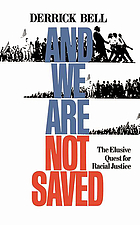
With its liberal orientation, social political philosophy honors the alleged progress of the Civil Rights Movement. The traditional view of the 1960s and 1970s is that the period saw profound social transformation and dramatically increased awareness by white Americans. Black Americans adamantly disagree with this view and as a result have often been cast as pessimists or fatalists. It was W. E. B. Du Bois’s view that the racial equality championed by the Civil Rights Movement was an illusion and little more than an effort by the United States to preserve its soft power over communism during the Cold War. This position served as the basis of multiple reflections on the institutional and global nature of white supremacism and motivated many of the premises that now fall under the rubric of critical race theory. Established as an intellectual tradition by Derrick Bell in the early 1980s, critical race theory begins with the assumption that the gains of the Civil Rights Movement were not contingent on sustainable changes in the racial organization and institutional structure of American democracy. In And We Are Not Saved: The Elusive Quest for Racial Justice, Derrick Bell argues that the rights won during the Civil Rights Movement were subject to economic fluctuation and white racial interests. In other words, American civil rights doctrines and laws were little more than symbolic gestures used to maintain societal stability and diffuse black radicalism. Civil rights, according to Bell, were based on the fluctuating interests of rich and poor whites, and when black progress severely disadvantaged one of those groups those civil rights would be legally challenged and socially restricted. This idea was called interest convergence. It maintained that blacks in the United States would be allowed to progress as long as their agenda did not conflict with the interests of a broad groups of whites. In short, black rights would remain secure or be rewarded as long as those rights aligned with the interests of the dominant white group. As illustrated in Bell’s now-famous short story “The Space Traders,” which Bell published in Faces at the Bottom of the Well: The Permanence of Racism, Bell believed racism was a permanent feature of American society. As Bell wrote in his introduction to Faces at the Bottom of the Well, “Despite undeniable progress for many, no African Americans are insulated from incidents of racial discrimination. Our careers, even our lives, are threatened because of our color. Even the most successful of us are haunted by the plight of our less fortunate brethren who struggle for existence in what some social scientists call the ‘underclass.’ Burdened with life-long poverty and soul devastating despair, they live beyond the pale of the American Dream.” Bell continued this idea in Silent Covenants: Brown v. Board of Education and the Unfulfilled Hopes for Racial Reform, but he argued that interest convergence was more accurately described as a kind of fortuity. In other words, the outcomes of racial doctrines or overlapping interest to the benefit of black people could not be predicted—they were simply the outcome of the power dynamics between differing groups of whites. This position leads to the inevitable conclusion that even in the twenty-first century the racial advances of the late twentieth are merely symbols and window dressing. The most authoritative collection of the early writings on critical race theory is Critical Race Theory: The Key Writings That Formed the Movement, edited by Kimberlé Crenshaw, which includes contributions by Bell.
The “permanence of racism” thesis articulated by Bell has been reimagined in recent years: it has moved away from the legal, historical, and sociological approaches of the 1980s and 1990s and toward psychoanalytic and semiotic accounts of black suffering. Taking up the idea that anti-black racism is in fact a permanent and never-changing aspect of American society, contemporary Afro-pessimists have begun to approach the subject through analysis of the white/human and black/slave ontology. Frank Wilderson, in Red, White and Black: Cinema and the Structure of U.S. Antagonisms, maintains that blackness is synonymous with slavery. Despite the election of its first black president, Wilderson argues, well into the second decade of the twenty-first century blackness is defined in the United States as outside of humanity, i.e., it cannot be conceptually captured by the idea of the human. Saidiya Hartmann expands on this point in Scenes of Subjection: Terror, Slavery, and Self-Making in Nineteenth-Century America, writing in chapter 1 that “the fungibility of the commodity makes the captive body an abstract and empty vessel vulnerable to the projection of others’ feelings, ideas, desires, and values; and, as property, the dispossessed body of the enslaved is the surrogate for the master’s body since it guarantees his disembodied universality and acts as the sign of his power and dominion.” Neil Roberts’s Freedom as Marronage introduces some worthwhile conceptual and historical challenges by imagining the antipathy between the human and the slave in the practice of marronage (which refers to running away from the plantation, either temporarily or permanently), which will have to be engaged in the coming years.
 And we are not saved : the elusive quest for racial justice by
And we are not saved : the elusive quest for racial justice by